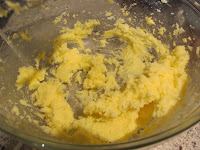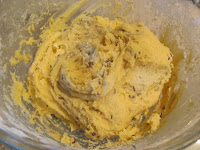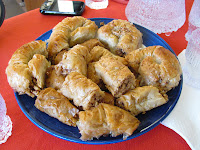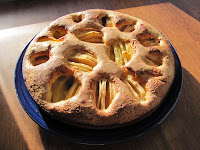Though everyone in my family loves eating, we all tend towards obscenely busy lives, and as such food has had to work in around it - except for me, since food is what tends to make me busy. ;-)
There's also that whole glamourising the past thing - often the perception seems to be that ye olde foode is better than what we have now - and it might be if all you eat is pre-packaged convenience stuff (I've nothing against convenience food every now and then, by the way) - but over time we tend to improve on things, and we are generally much weathier than our forebears and have many more foodstuffs at our fingertips. I guess what I'm really trying to say is that I'm glad that my meals aren't all meat and three veg, and that I don't have much call for lard in my kitchen.
Anyway, when I asked Mum if she could think of family heritage recipes we didn't get very far. Rice bubble crunch, which Grandma apparently used to make often, hardly seemed worthy. Making a Sunday roast, though certainly a family tradition (dinner is still at lunchtime on Sunday for my grandparents) didn't quite fit the bill for a bake-off. My Nana (Dad's Mum) used to make a mean pav but we don't have her recipe. Mum did mention that her grandmother used to often have seed cake - something which seems to have fallen out of favour.
Then I spied a challenge on The Wheeling Gourmet - the 1914 version of the Edmonds Cookbook (Sure to Rise!) is online, and he put out the call for folks to try a recipe from that version against the modern equivalent, to see the effect of the passage of time. If you want to join in let the Wheeling Gourmet know by commenting on his post - you don't need a blog, just to send him some notes and photos of your results.
Seed cake features in both the 1914 version of the recipe and the one from my 1998 Edmonds Cookbook, and there are quite a few differences between them. For starters, the older one had three times (!) as many eggs. I hypothesised that perhaps eggs were smaller on average back then - since we breed livestock for production optimality (if you'll excuse my economist-influenced turn of phrase!) I wonder if the average size of an egg has increased in the last 100 years.
As it turned out, despite only having a third more flour and similar quantities of butter and sugar, the older recipe actually made about twice as much cake. Could the change in proportion relate to the relative cost of ingredients - did flour cost relatively more back then?
As well as the quantity variations the older recipe was decidedly scant on details. I appreciate that ranges would have been the primary cooking device and temperature control was perhaps not so refined as to make instructions such as "Preheat oven to 180 C" but there wasn't an indication of cooking time either - in fact, the recipe stopped short after mixing the ingredients. Perhaps the intention was to eat the batter raw. ;-)
Many of the other recipes in the 1914 book have instructions such as "cook in the usual way" - with such oblique directions it amazes me the cookbook established itself so thoroughly in Kiwi culture - but then I suppose women tended to have a firmer grounding in the domestic science in those days, and perhaps secrets such as what constituted "the usual way" were passed down through the generations.
I baked the modern version in a loaf tin and the other in a round cake tin, so it would be easy to know which was which. I definitely preferred the loaf look - but all bar one of the bake-off attendees preferred the older version. It was moister and definitely eggier and the lemon (which you could easily add to the other one, of course) was a great accent flavour for the distinctive caraway seeds.
Either way this is definitely the sort of cake you have with a cuppa - perhaps slathered with butter, though fresh it was fine on its own.
The other bake-off fare all seemed to me to be much more interesting - gougère (French cheesy choux pastries); versunkener apfelkuechen (German apple cake) and stunning baklava - and was all enjoyed greatly.
Do you have any family recipes that have been passed down through the generations?
Seed Cake (adapted from the 1998 Edmonds Cookbook)
Ingredients
125g butter, softened
1/2 cup sugar
1 Tbsp whisky or brandy (optional)
1 1/2 cups flour
1 1/2 tsp baking powder
2 eggs
1 Tbsp caraway seeds
Preheat oven to 180 C. Grease and line a loaf tin.
Cream butter and sugar until light and fluffy. Add whisky or brandy, if using. Sift flour and baking powder together. Add eggs alternately with dry ingredients. Mix in caraway seeds. Spread mixture in the prepared tin. Bake for 30-35 minutes or until cooked through.
225g butter
225g sugar
6 eggs
2 cups flour
1 tsp baking powder
1 Tbsp caraway seeds
zest of 1 lemon
Preheat oven to 180 C. Grease and line an 18cm square cake tin or two loaf tins
Cream butter and sugar, then add the eggs, beating in one by one. Add the dry ingredients, seeds and lemon zest and mix to combine.
Bake for 30-35 minutes or until baked through.






















 Hi! I'm Rosa, a.k.a. Mrs Cake, and I live in Wellington, New Zealand. I love food in all its forms, my fabulous family, and a bit of good old-fashioned Kiwi DIY. This blog started around food but has evolved to include some other bits and pieces - I hope you'll join me for the journey!
Hi! I'm Rosa, a.k.a. Mrs Cake, and I live in Wellington, New Zealand. I love food in all its forms, my fabulous family, and a bit of good old-fashioned Kiwi DIY. This blog started around food but has evolved to include some other bits and pieces - I hope you'll join me for the journey!
what a cool themed morning tea.. this sort of reminds me of when my dad turned 50, he had a morning tea at his work where we made food from the fifties for him to take along - apparently it was a hit! i know what you mean about the scant instructions .. we have a 1950's edmonds book and even it's rather brief!
ReplyDeleteIt's funny you should post this this week; I'm in the middle of planning some family heritage recipe posts for my blog. I'm lucky enough to have my grandmother's, and even my great-grandmother's recipe books at my disposal. My great-grandmother did most of her family cooking on the farm in the 1920s and 30s, and I'm going to be posting a few of her baking recipes over the next wee while. Her instructions are brief, too, or even non-existent for some things!
ReplyDeleteI love seed cake, it is such a great morning tea item. And what a lovely idea for a themed bake-off! Lovely post, Rosa.
I like how many more eggs are in the 1914 version! I'm thinking about joining in on this challenge, good to see your results :)
ReplyDeleteThe main advantage of seed cake in the 1960s was that the children [ie:us] didnt like it so it lasted really well. We were never quite sure whether they were really seeds or SOMETHING ELSE!
ReplyDeleteGeorgi, that's a lovely way to celebrate a 50th birthday!
ReplyDeleteMillie, you should definitely join the challenge, it's quite interesting - I see that the first entrant in the challenge had a similar shift in egg proportions in their recipe. I'd love to know what drove the change!
Mum, even just as seeds I can see it's not so much a kid-friendly flavour - but what else did you think they could be???
Ha ha ha - eat the batter! I loved that comment you made. A very interesting experiment.
ReplyDeletemakeitgiveit, the recipe seemed to be geared towards it and I'm never averse to a bit of bowl-licking. ;-)
ReplyDeleteWhat a great read! I'm so glad that someone else had the feeling of being left in the lurch without clear instructions on the oven temperature or timings. In future I reckon I'll cook with the recipes side by side. 1914 for the taste, contemporary edition so I don't have to rely on 'smell' to know when they're done!
ReplyDeleteVexus Nexus, those 1914 instructions were definitely a bit oblique! Hope your recipe worked out well too. :-)
ReplyDelete